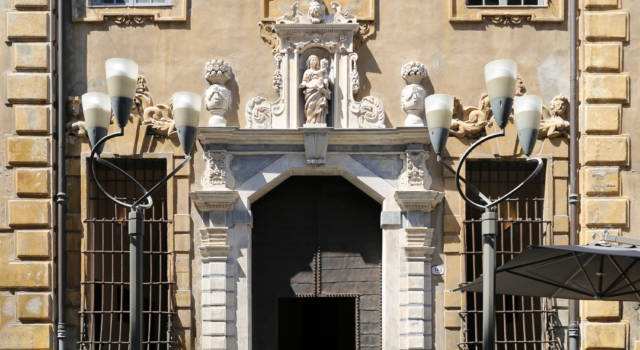The majestic palace, which represents the most important civil building of the city and the biggest of all the Western Liguria, has always been the lavish residence of the family Borea D’Olmo, one of the most ancient and prestigious families of the city since the 15th century.
The five floors palace is decorated with a large Renaissance cornice, that resumes the baroques walls below.The complex, that was surrounded by a park and agricultural plots that later disappeared because of the expansion of the buildings, has been restored a lot of times since the 15th century, until it assumed its current structure in the Baroque period.
The entrance is characterized by two sixteenth-century marble portals which connect to two streets: Cavour Street and Matteotti Street; it also has the original doors made of wood lined with iron. The two big portals are surmounted by other niches, which host the statue of the Virgin with the Baby on the south and Saint John the Baptist statue on the west; this latter was probably reconnected with the name of some exponents of the Borea Family. Each statue was made by the Florentine sculptor Fra’ Giovanni Angelo da Montorsoli, Michelangelo’s apprentice.
the Virgin’s portal leads to the atrium-staircase in the Genoese style, composed by two spaces: the first one is characterized by a wide pavilion-vaulted ceiling while the second one, on the back and slightly raised, is has a cross vault ceiling with marmoreal columns.
A wide main staircase leads to the first floor appartments where the family dwelled, while the servants lived in the most simple and modest upper floors.
The first noble floor that actually is not accessible because it is private, was transformed and decorated at the end of the seventeenth-century by the Genoese painter Giovanni Battista Merano. Among the rooms, the gallery stand out, adorned by mirrors, busts and paintings, which represent an architectural solution adopted by the major baroque houses. The same Merano painted “Le Storie Della Passione” which decorate the chapel at the first floor and contains also a Van Dyck’s painting that represents the Crocifissione.
The second noble floor, before it was moved to Palazzo Nota in 2016, hosts the Town Museum of Sanremo and has the bedroom that hosted Pope Pio VII in the night of 11th February 1814, together with a chapel and large rooms decorated in eighteenth-century.
During his life, Borea D’olmo palace was well preserved despite of the 1787 earthquake and the Second World War. It hosted many important people: the queen of Spain Elisabetta Farnese in 1714 and in 1756; the King of Sardinia Carlo Emanuele III of Savoy in 1746; the Infante of Spain Philip of Bourbon in 1747; the French painter Jean-Honoré Fragonard in 1773; Queen Maria Cristina of Savoy in 1843 and Prince Philip of Edinburgh in 1948.
The Boreas, originating in Brittany, were known between the 12th and 14th centuries in
Venice where they held important positions at the Maggior Consiglio and in Romagna
where in 1420 they got their noble title by Pope Martin V.
In 1430 an exponent of the family, Antonio Borea, moved to Sanremo where he became Podestà and had a small building built at Porta di Saint Stephen. We have to wait however for 1498 to see the laying of the first stone of the present building by Gio Batta Borea.
Desde aquel momento la familia Borea permaneció establemente en Sanremo; muchos de sus componentes se distinguieron sobre todo al servicio de la iglesia y de sus instituciones públicas, siempre queridos por el pueblo por su grande generosidad y disponibilidad hacia lo más pobres e infelices.
From that moment the Borea family stayed in Sanremo with several of its own members who distinguished themselves in a particular way at the service of the Church and public institutions, always getting loved by the population for their great generosity and availability towards the poorest and the miserable.
In 6th July 1773 the family obtained the title of Marquis of Olmo from the King of Sardinia Vittorio Amedeo III, while in 1813 Tomaso Gio Batta, mayor of Sanremo, got the title of Baron of the French Empire. In 1914 the family was finally elevated to the dukal dignity from the king of Italy Vittorio Emanuele III. During their long stay in our city the Borea d’Olmos gave Sanremo numerous important personalities, including brave soldiers, men of culture, diplomats, administrators and mayors.
Giovanni da Montorsoli
Fraile Giovanni Angelo de Montorsoli ( 1507 – 1563 ) uno de los mayores rapresentantes del manierismo al estilo de Miguelangel, colaboró varias veces con el mismo Miguelangel en la realización de la Sacrestía Nueva de San Lorenzo en Florencia . Entre las otras obras suyas destacan la fuente de Orión y del Neptuno en Messina y el altar mayor de la iglesia boloñesa de Santa Maria dei Servi. Como vivió varios años en Liguria , y en particular en Génova, donde realizó la estatua de Andrea Doria que se encuentra en el mausoleo de la noble familia genovés en la iglesia de San Mateo, es muy probable que el mismo hubiera diseñado los portales destinados a acoger las esculturas que le había encargado la familia Borea
The pope’s visit
A bedroom in the building is particularly suggestive as it is known for having hosted, on the night between 11th and 12th February 1814, Pope Pius VII during his return trip to Rome from the French exile at Fontainebleau. This room has been preserved in its original appearance characterized by lively vault decoration, where hosts of dancing angels chase each other in the sky. The space of the bed is then clearly separated from the antistanza through an arch, while two small doors open to the sides to allow access to the dressing rooms. After departure of the pope, the Borea family had affixed to the doors of the room and of the hall where the Pope had stayed, two commemorative plaques, whose text was approved by Pius VII himself, who read it before leaving the palace.



